Table of contents
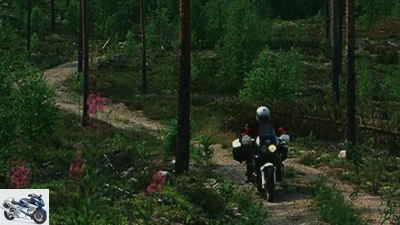
Josef Seitz
to travel
Southern Finland
Southern Finland
The pleasure of the north
Finland means water, forest and endless slopes. Whoever lives here must be able to deal with loneliness and nature to the highest degree. Who travels here, as well. Mosquitoes and reindeer are sometimes the only companions.
Josef Seitz
07/22/2005
Get off the ferry, quickly pack some groceries at the port market and then head north. The canyons of houses in the Finnish capital Helsinki on the extreme southern tip of the country have soon disappeared from the rear-view mirrors, and I turn to small back streets. As if Finland wanted to give the lie to all the horror stories of monotonous, curve-free road construction, marvelous tar and gravel roads meander between cultivated fields and untouched forest landscapes up to Paijannesee. Behind Asikkala, the road balances for kilometers on a tiny, natural ridge just above the surface of the water, which is sometimes hardly wider than the road itself.
Only when my eyes almost close a little later do I realize that the clock shows almost midnight. The sun shines untiringly like at home in the late afternoon. On the spur of the moment, I roll out the sleeping bag on the veranda of an uninhabited fisherman’s hut and hide in it as best I can. On the one hand, to have it at least a little darker, on the other hand as protection from the mosquitoes.
The next stop is Muurame. This is where the original Finnish institution par excellence was honored – with a sauna museum. And compiled everything that has to do with voluntary sweating. The history of the sauna began more than a thousand years ago in a covered hole in the ground, which was replaced by a smoke sauna and finally by the log sauna as it is still relevant today. In the past, the sauna room often functioned as a kitchen, bathroom and smokehouse at the same time. Even the grain for brewing beer was dried in it. Even if the spatial differentiation is now stricter, a house without a sauna would be unthinkable for a Finn. He would rather leave the roof off than do without the beloved steam room.
At the moment I’m sweating even without hot steam. Twenty-nine degrees of humidity in the shade make the air look oppressive and humid. The way back over the Paijannesee and then the 431 towards Mikkeli offers a little cooling. Unfortunately, the streets there now correspond to the Finnish cliche: functional straight and a long curve every few kilometers. But shortly before Mikkeli, I’m really happy about the clear division. Because within a few minutes the sky is zapping, as if out of nowhere thunderous squalls break down on the treetops, and shortly afterwards it begins to pour, as if the deluge was coming. I clamp myself behind a blue delivery van, which I can at least make out vaguely through the wall of water, until the awning of a supermarket rescues me shortly before Mikkeli. Suddenly a crack fills the air and a full-grown pine hits the tar exactly where I turned two minutes ago. The spook lasts twenty minutes. Then the wind dies down as quickly as it came, and the rain just drizzles down innocently. I’m going to the next campsite. The next morning I learned from the landlord that the storm knocked down thousands of trees and isolated one hundred thousand households from the power grid. Well, forest and water are the soul of Finland, nature is part of life here.
It gets wetter with every meter to the east. From above as from below. I have reached the east coast of Lake Saimaa, the largest inland body of water in the country. Although eight times the size of Lake Constance, it just looks like a large pond when you drive by. Countless indentations and islands prevent any overview. The lake is particularly important for the timber industry. Pulled by small tug boats, tons of logs can be transported over long distances to the wood processing centers in the south using floating pontoons. A tradition that has been practiced for centuries.
Buy complete article
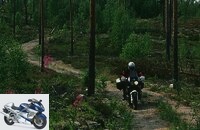
Southern Finland
The pleasure of the north
10 pages) as PDF
€ 2.00
Buy now
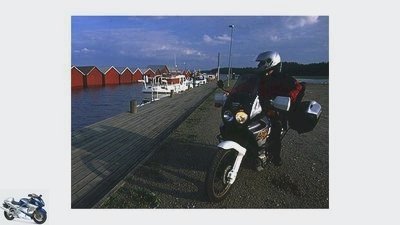
Josef Seitz
Even watercraft need a roof over their heads: boat huts in the port of Kerimaki.
While the rain is gradually beating me up, it doesn’t seem to affect the Finns in any way. Undaunted, they stand on the bank rocks and skilfully hurl their fishhooks over streams and lakes. On rainy days like this the fish would bite best, I learn over a cup of coffee. In addition, it is Saturday, so you have time, and the weather is then of secondary importance. I try to make this philosophy my own, but it works with only moderate success.
In Imatra, too, water is the dominant theme, this time staged as an impressive drama. The power station there opens the locks every evening and lets massive amounts of water pour through a narrow gorge into the Vuoksi. A spectacle that attracted tsars and emperors to the town as early as the 19th century.
Orienting myself to the position of the sun, I try to advance from Imatra to the northeast on the smallest of paths. When I pass the same farmhouse for the second time, I’m pretty puzzled. Without thinking that the sun in Finland is almost in the north late at night at this time of year, I drew a complete circle. It works better the second time. At Sarkilahti I discover a wonderful place to sleep right on the lakeshore. The only problem: the mosquitoes. Even when setting up my tent, I can hardly save myself from them.
The mosquitoes disappeared the next morning, but an older Finn is standing next to my tent. Neither of them understands a word of the other, but I can tell from their gestures that I am obviously camping on their fishing spot. Okay, I’ll be off in a minute. What he is trying to tell me when he suddenly crawls across the ground on all fours and constantly pointing into the forest is a mystery to me. It wasn’t until an hour later and two kilometers further on it dawned on me – when a farmer’s wife explained to me that in recent years a female bear with her cubs has been seen time and again in the local forests.
The forest is not only the soul of Finland, economically it is also the backbone. Fifty million cubic meters of wood are processed or exported every year. Thanks to ingenious forest management, the stock is still growing by around 15 million solid cubic meters annually. With this in mind, there is a museum in Punkaharju that is perhaps even better suited to Finland than the sauna museum: the Lusto Forest Museum. In addition to a lot of information on the subject of forests, native animals are projected onto a huge panoramic screen in a glowing autumn landscape. I feel like I’m in the jungle.
But it gets even better. A little later, in the small town of Kerimaki, I am standing in front of what is supposedly the largest wooden church in the world. A Finn who emigrated to America is said to have donated the church to his hometown. It is said that he sent the measurements with the dollars. Nobody could have known that he had given it in feet instead of meters
Behind Kitee it goes up to Tohmajarvi and on to Vartsila to the Russian border. A strange feeling arises when large signs in the fields announce the prohibition zone in multiple languages and unmistakably. Beyond the borderline there is untouched, wild nature – the territory of bears and wolves. But not only they act as border guards. There is another, tiny, international and merciless. The mosquito. With a short photo stop, I have no choice but to continue driving in panic. Thousands of pests buzz around my ears in a density, as if they wanted to devour me. It gets even more unbearable at the campsite near Ilomantsi. But the campsite owner reassures me. That is not so bad today. If there are really many mosquitos, then a dark cloud is circling the head. I only see my salvation as I flee into the tent – and the next morning I buy what I already smiled about at some of my contemporaries today: a beekeeper hat.
Southern Finland (2)
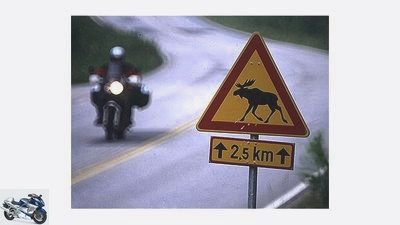
Josef Seitz
Moose, forest and water: Unfortunately, the former can mainly be seen on signs as in real life.
At Hattuvaara a large sign reads “To the easternmost point of the EU”. To get there, a permit from the border authorities is required, which is issued quickly and in a friendly manner at the border office in Hattuvaara. Then the Africa Twin rolls east on a roughly graveled runway. At some point the path crosses the dark waters of the Koitajoki River and ends after 18 kilometers at a lonely hut in front of a lake. You couldn’t have chosen a nicer place for the eastern end of Europe. If the two border posts – the Finnish one in blue and white, the Russian one in red and green – were not facing each other on an island in the middle of the lake like two border guards, I would be sure to be standing on an untouched piece of earth. For a long time I ponder the fact that the First and Second Worlds met here once, finally I drive back to Hattuvaara and let the Honda glide further north on the 522. More than a hundred kilometers long there is nothing but lonely forest areas. Only a few lakes and tundra-like plains interrupt the green wall of pine trees. Here it begins, the wilderness of the north of Finland. Sheer nature that requires adaptation from anyone who wants to live in it. The Pielinenmuseum in Lieksa shows the means with which the Finns have mastered this over the centuries. Over seventy buildings from the surrounding area have been brought together to form a museum village. The forest has always been the basis for life. Whether soup spoons, cartwheels or chip lamps – almost anything could be made from wood.
With Nurmes I reach the most northerly point of my trip and after circumnavigating the northern tip of Lake Pielinen also the highlight of the tour. Topographically at least: At 347 meters above sea level, Mount Koli is the highest that southern Finland has to offer. Reason enough to declare the area a national park. But apparently also to set up a ski lift and build a summit hotel. The way up leads through five (!) Correct curves including a serpentine. After all – the Koli offers one of the rare views over the forest and lake landscape. Like a carpet of needles and water, it disappears far on the horizon, green and gray presumably up to the Arctic Ocean.
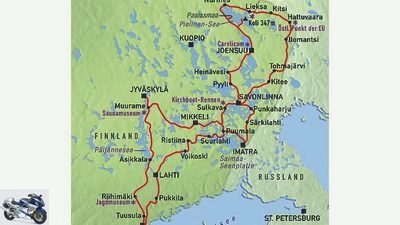
Map: Maucher
To the west of Lake Hoytiainen and past Kermajarvi, the Honda rolls further south to Heinavesi. An inconspicuous place where a Finn asks me in bumpy German to photograph the church tower. His mother sat up there with binoculars during the war and kept an eye out for Russian bombers. And after Finland stood on the German side in the war, he thinks it should be worth a picture. I also have to try the Finnish strawberries. They are the best in the world.
But first I try the piste via Pyyli down to Savonlinna and on to Sulkava. The traditional church boat race is to take place there on the weekend. When roads in the forests were still in short supply and many settlements were barely accessible, people often had to cover long distances in the lake labyrinth. Whole village communities were sometimes on the way to the big church festivals by boat. In Sulkava – how could it be otherwise in Finland – a race emerged from this. Up to fourteen rowers sit in the long boats, which reach amazing speeds. However, the top speed is less important than the endurance. The race goes over many kilometers through forest and river landscapes. After the mass start, the boats disappear on the horizon – and in Sulkava it’s time to party. Classic Finnish with lots of beer, fish and bratwurst. Around midnight, after I had lost sight of the racing action for a long time, the modern part comes: Showtime for the Ami sledges. Finns love American road cruisers and at night cruise down the promenade and illegal racetracks of the villages in their huge boxes. When I crawl into my sleeping bag in the early hours of the morning, the party is still in full swing.
Around noon I set off towards Lake Saimaa. The side road to Suurlahti haunts fifteen kilometers on a board-hard track through quiet forests and along lakes. Then there is a fantastic motorcycle route over to Ristiina and towards Lahti, where the huge orphaned ski jumps poke bizarrely into the sky in summer. In the evening I treat myself to the last four-euro plastic mug of beer on the campsite at Lake Tuusula and enjoy the oblique rays of the sun slowly moving north again. The next morning I’m back in the Helsinki harbor market. This time with a basket of strawberries in my luggage. The man from Heinavesi was right. You are world class.
Southern Finland (info)
With 338,000 square kilometers, Finland is almost the size of Germany, but only a good five instead of 82 million inhabitants. Nature lovers are right here. And beyond the main routes, despite the opposite image, there are quite attractive motorcycle routes to be found. An enduro makes it easier to get ahead occasionally, but it is not absolutely necessary.
getting there
Direct ferries to Helsinki and Hanko leave from Rostock or Travemunde. At Superfast, for example, the 21-hour passage Rostock – Hanko costs from 161 euros in the cabin and 84 in the Pullmann seat. The motorcycle travels for 56 euros. Combination tickets for Finland, Sweden, Denmark are possible. It is also advisable to make reservations outside the main season. Telephone 0451/88006166 or www.superfast.com. A Scandinavian ferry overview was published in MOTORRAD 12/2005.
gastronomy
First the dramatic: A beer in a plastic cup on the campsite costs around four euros. Non-alcoholic is much cheaper and food is almost cheap. In the Ravintola (simple restaurant) there is the nice tradition of the daily menu for less than ten euros: soup, main course, salad buffet, bread, non-alcoholic drinks plus coffee. There is often a barbecue area with free firewood on campsites.
Stay
The choice of campsites is quite high, they are shown on the maps. If you don’t want to camp, you can also rent a hut. The equipment ranges from bunk beds to the luxury version with kitchen, shower and sauna. Prices start at around 30 euros. Each campsite usually even offers several sauna options for a surcharge. During the main travel season, it is advisable to make a reservation by telephone, especially on weekends. Hotels are available in almost every major town. However, the prices are moving in dizzying dimensions. Two recommendations: The border hotel (Rajahoteli) Korpiskelka is located on the route along the Russian border between Kitee and Ilomantsi and offers accommodation in massive wooden houses. Information at www.korpiselka.com. The German-run Waldsee-Ferienhof Loma-Kitsa is located in a quiet and idyllic location on a lake. Kitsantie 6 in 82870 Luutalathi / Tuuovaara, with cabins and apartments. Telephone and fax 00358 / (0) 13/864150.
Worth seeing
The Hunting Museum in Riihimaki provides an overview of the Finnish fauna (and weapons). It is more domestic in the sauna museum in Muurame and highly dramatic in the power station in Imatra, where the rapids are flooded every day. A purely geographical attraction is the easternmost point of western Europe. The permit is obtained within a few minutes from the tourist information office in Ilomantsi by fax or issued directly at the border office in Hattuvaara, then you can take the roughly graveled route to the Russian border point. The open-air facility of the »Pielinenmuseum« in Lieksa gives an idea of life in the woods. In Joensuu, the modern Carelicum specializes in the history of Karelia. Unfortunately only once a year, always on the second weekend in July, Sulkava invites you to the traditional church boat race.
information
Finnish National Tourist Board, Lessingstrasse 5, 60325 Frankfurt, phone 069/50070157, fax 7241725 or www.visitfinland.de.
Enduro
The driven route is seasoned with some gravel and sand slopes. These are completely normal connecting routes that can be mastered with any motorcycle without any problems. If you are looking for more off-road, you will find it with good maps in eastern Finland. But please stay on the slopes. The Finnish nature is very sensitive due to the harsh climatic conditions and takes decades to recover from damage.
literature
The Goldstadt travel guide “South and Central Finland” for EUR 14.80 is very informative for the southern half of the country. For Karelia and the Saimaa Lake District, we recommend “Finland: Discover Saimaa and Karelia for yourself” from the Elch edition for € 18.80. Despite the mega-scale 1: 800000, RV’s Finland map is ideal for finding your way, as most of the small streets and paths are also shown. If you need more precise map material, you can use the Finland GT maps available locally in 1: 200000.
Related articles
-
Roeseler to travel Through Finland by motorcycle On the way: Finland Motorcycle tour through Finland Once a year, the best motorists in the world meet in…
-
to travel Southern sweden Southern sweden Bullerby is everywhere Anyone looking for a nice rhyme for life should get to know Sweden. There is almost…
-
Motorcycle tour in southern Norway
Dirk Schafer 18th pictures Dirk Schafer 1/18 There quickly: via Hirtshals / Denmark to the Norwegian ferry port Kristiansand. Dirk Schafer 2/18 Excellent…
-
Siepmann to travel Winter tour Finland Winter tour Finland Ice age on the motorcycle To explore one’s own limits and those of the 34-year-old Guzzi was…
-
Out and about: BMW GS Trophy in southern Africa
black to travel Out and about: BMW GS Trophy in southern Africa Out and about: BMW GS Trophy in southern Africa Motorcycle adventure with the BMW F 800…
-
Motorbike rental in southern Europe and Turkey
Iron ham to travel Motorbike rental in southern Europe and Turkey Motorbike rental in southern Europe and Turkey Escape agent No question about it, there…
-
Motorcycle tour in southern England: From Dover to Land’s End
Jo Deleker 14th pictures Jo Deleker 1/14 The plan is simple: I want to cross southern England, from Dover to Land’s End, and use these single-lane roads…
-
Kymiring Finland: New racetrack, also for MotoGP
Arkkitehdit Sankari Osakeyhtio 9 pictures Arkkitehdit Sankari Osakeyhtio 1/9 With the Kymiring, Finland is getting a new racing course with an…
-
Motorcycle tour tips for southern Germany
MAIRDUMONT / Claudia Werel 10 pictures MAIRDUMONT / Claudia Werel 1/10 MAIRDUMONT / Claudia Werel 2/10 MAIRDUMONT / Claudia Werel 3/10 MAIRDUMONT /…
-
Out and about in the Cevennes (southern France)
Deleker 17th pictures Map: MAIRDUMONT / Claudia Werel 1/17 1500 kilometers were covered in ten days. Deleker 2/17 Meeting point: motorbikes in the small…